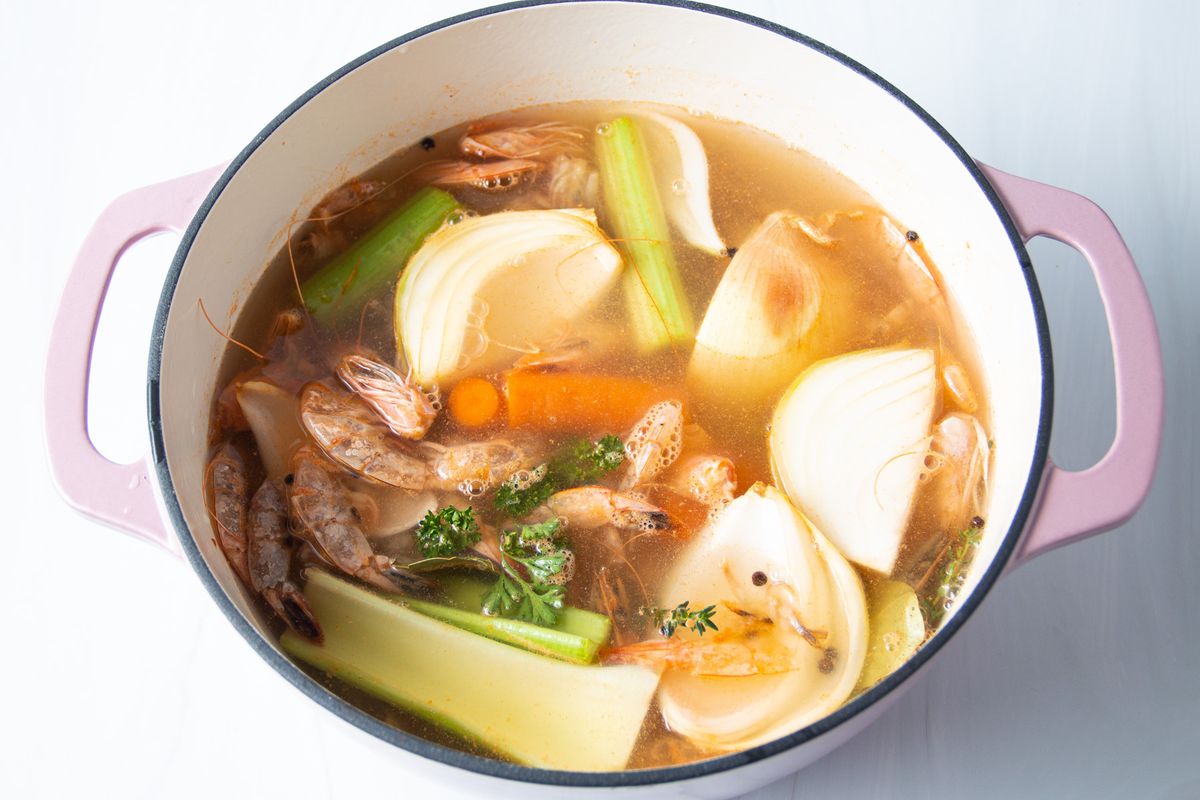Creating a rich and flavorful shrimp stock is a fantastic way to elevate your seafood dishes. This homemade stock is perfect for soups, stews, and risottos, adding depth and complexity to your recipes. Plus, it's a great way to make use of shrimp shells that might otherwise go to waste.
Some ingredients in this recipe might not be commonly found in every household. Shrimp shells are the primary component and can be obtained by peeling fresh shrimp. Thyme and bay leaf are aromatic herbs that may not be in everyone's pantry but are easily found in the spice section of any supermarket. Make sure to pick up fresh celery, carrot, and onion from the produce section.

Ingredients For Shrimp Stock Recipe
Shrimp shells: The outer coverings of shrimp, which provide a rich seafood flavor when simmered.
Onion: Adds sweetness and depth to the stock.
Celery: Contributes a subtle earthiness and enhances the overall flavor.
Carrot: Adds a hint of sweetness and color to the stock.
Garlic: Provides a robust and aromatic flavor.
Water: The base liquid for the stock.
Salt: Enhances the flavors of all the ingredients.
Black peppercorns: Adds a mild heat and complexity.
Thyme: An aromatic herb that adds a subtle, earthy flavor.
Bay leaf: Adds a layer of herbal flavor and complexity.
Technique Tip for Shrimp Stock
When making shrimp stock, it's essential to extract as much flavor as possible from the shrimp shells. To enhance the depth of flavor, consider roasting the shrimp shells in a 400°F oven for about 10 minutes before adding them to the pot. This step caramelizes the natural sugars in the shells, resulting in a richer, more complex stock.
Suggested Side Dishes
Alternative Ingredients
Shrimp shells - Substitute with fish bones: Fish bones provide a similar seafood flavor and can be used to create a rich stock.
Shrimp shells - Substitute with lobster shells: Lobster shells offer a comparable depth of flavor and can be used to make a luxurious stock.
Shrimp shells - Substitute with crab shells: Crab shells can impart a similar seafood essence to the stock.
Chopped onion - Substitute with leek: Leeks provide a mild onion flavor and can be used in place of onions in stocks.
Chopped onion - Substitute with shallots: Shallots offer a sweeter and more delicate flavor compared to onions.
Chopped celery - Substitute with fennel: Fennel has a similar texture and adds a subtle anise flavor to the stock.
Chopped celery - Substitute with celery root: Celery root provides a similar flavor profile and can be used as a substitute.
Chopped carrot - Substitute with parsnip: Parsnips have a slightly sweeter taste and can be used in place of carrots.
Chopped carrot - Substitute with sweet potato: Sweet potatoes add a different but complementary sweetness to the stock.
Smashed garlic - Substitute with garlic powder: Garlic powder can be used if fresh garlic is unavailable, though it will have a slightly different intensity.
Smashed garlic - Substitute with shallots: Shallots can provide a milder garlic-like flavor.
Water - Substitute with vegetable broth: Vegetable broth adds additional depth and flavor to the stock.
Water - Substitute with chicken broth: Chicken broth can enhance the richness of the stock.
Salt - Substitute with soy sauce: Soy sauce can add a salty and umami flavor to the stock.
Salt - Substitute with seaweed: Seaweed can provide a natural salty flavor and additional umami.
Black peppercorns - Substitute with white peppercorns: White peppercorns offer a similar heat but a slightly different flavor profile.
Black peppercorns - Substitute with red pepper flakes: Red pepper flakes add a bit of heat and a different type of spiciness.
Thyme - Substitute with oregano: Oregano has a similar earthy flavor and can be used as a substitute.
Thyme - Substitute with rosemary: Rosemary provides a robust and aromatic flavor similar to thyme.
Bay leaf - Substitute with oregano: Oregano can provide a similar earthy and slightly bitter flavor.
Bay leaf - Substitute with thyme: Thyme can offer a comparable depth of flavor to bay leaves.
Other Alternative Recipes Similar to This
How to Store / Freeze Your Shrimp Stock
- Allow the shrimp stock to cool completely before storing. This helps prevent condensation, which can dilute the stock and affect its flavor.
- Pour the cooled shrimp stock into airtight containers or heavy-duty freezer bags. If using bags, lay them flat in the freezer to save space and ensure even freezing.
- Label each container or bag with the date and contents. This helps you keep track of how long the stock has been stored and ensures you use the oldest stock first.
- Store the shrimp stock in the refrigerator if you plan to use it within 3 days. For longer storage, place it in the freezer where it can last up to 3 months.
- If freezing in containers, leave some space at the top to allow for expansion as the stock freezes. This prevents the container from cracking.
- For convenience, consider freezing the shrimp stock in ice cube trays. Once frozen, transfer the cubes to a freezer bag. This allows you to easily portion out small amounts of stock as needed.
- When ready to use frozen shrimp stock, thaw it in the refrigerator overnight or use the defrost setting on your microwave. Avoid thawing at room temperature to prevent bacterial growth.
- Reheat the shrimp stock gently on the stove over low heat. Avoid boiling, as this can cause the flavors to become overly concentrated or bitter.
- If you notice any off smells or changes in color, discard the shrimp stock. Freshness is key to maintaining the best flavor and safety in your culinary creations.
How to Reheat Leftovers
Gently reheat the shrimp stock on the stovetop over medium heat. Pour the stock into a saucepan and bring it to a gentle simmer, stirring occasionally. This method ensures the flavors remain intact and the stock doesn't reduce too much.
Use a microwave-safe container to reheat the shrimp stock in the microwave. Cover the container with a microwave-safe lid or plastic wrap, leaving a small vent. Heat on medium power in 1-minute intervals, stirring in between, until the stock is heated through.
For a quick and even reheating, use a double boiler. Place the shrimp stock in the top part of the double boiler and simmer water in the bottom part. This gentle heating method prevents the stock from scorching and preserves its delicate flavors.
If you have a sous-vide machine, reheat the shrimp stock by placing it in a vacuum-sealed bag and immersing it in a water bath set to 140°F (60°C). This method ensures even heating without any risk of overcooking or losing flavor.
Reheat the shrimp stock in a slow cooker on the low setting. Pour the stock into the slow cooker and heat for about 1-2 hours, stirring occasionally. This method is perfect if you need to keep the stock warm for an extended period.
Best Tools for Making Shrimp Stock
Large pot: A large pot is essential for holding all the ingredients and allowing them to simmer together, extracting maximum flavor from the shrimp shells and vegetables.
Chopping board: A chopping board provides a stable surface for chopping the onion, celery, and carrot.
Chef's knife: A chef's knife is used to chop the vegetables and smash the garlic cloves.
Measuring spoons: Measuring spoons are used to measure out the salt and black peppercorns accurately.
Fine mesh strainer: A fine mesh strainer is used to strain the stock, ensuring a clear liquid free of solids.
Ladle: A ladle is helpful for skimming off any foam that forms on the surface of the simmering stock.
Storage containers: Storage containers are necessary for storing the stock in the fridge or freezer after it has been strained.
How to Save Time on Making Shrimp Stock
Use pre-chopped vegetables: Save time by buying pre-chopped onions, celery, and carrots from the store.
Batch cooking: Make a larger batch of shrimp stock and freeze it in portions for future use.
Quick thawing: If using frozen shrimp shells, thaw them quickly by placing them in a bowl of cold water.
Instant pot method: Use an Instant Pot to reduce the simmering time to about 15 minutes.
Pre-measure spices: Measure out the salt, peppercorns, thyme, and bay leaf ahead of time.

Shrimp Stock Recipe
Ingredients
Main Ingredients
- 1 lb Shrimp shells from about 2 pounds of shrimp
- 1 medium Onion chopped
- 2 stalks Celery chopped
- 1 medium Carrot chopped
- 2 cloves Garlic smashed
- 8 cups Water
- 1 teaspoon Salt
- 1 teaspoon Black peppercorns
- 2 sprigs Thyme
- 1 bay leaf Bay leaf
Instructions
- 1. Place all ingredients in a large pot.
- 2. Bring to a boil, then reduce to a simmer.
- 3. Simmer for 45 minutes, skimming off any foam.
- 4. Strain the stock through a fine mesh strainer.
- 5. Use immediately or store in the fridge for up to 3 days, or freeze for up to 3 months.
Nutritional Value
Keywords
More Amazing Recipes to Try 🙂
- Coconut Custard Pie Recipe1 Hours
- Rumchata Pudding Shots Recipe10 Minutes
- Butter Pecan Ice Cream Recipe45 Minutes
- Hello Dolly Bars Recipe35 Minutes
- Roquefort Pear Salad Recipe15 Minutes
- Stewed Apples Recipe30 Minutes
- Chocolate Cherry Cake Recipe55 Minutes
- Canned Apple Pie Filling Recipe45 Minutes


Leave a Reply